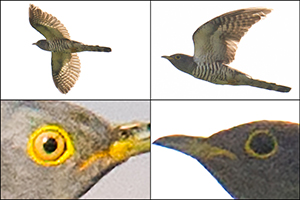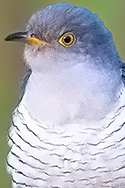In China, Hodgson’s Hawk-Cuckoo Hierococcyx nisicolor breeds south of Yangtze River. ID & COMPARISON Very similar to Rufous Hawk-Cuckoo H. hyperythrus. Adult has slaty-grey head and upperparts (paler than Rufous Hawk-Cuckoo); wings slightly darker grey. Prominent white crescent on innermost tertial; white nuchal patch also present. Long tail, square at end, grey with broad black subterminal band, followed by several narrow bands inward and rufous tip. Chin grey; throat mainly white. Breast, upper belly, and flanks streaked rufous and white (compare Rufous Hawk-Cuckoo, whose breast has a paler rufous wash). Lower belly and vent white; undertail white with black bands. Has yellow eye-ring. Juvenile browner above and barred rufous-brown; has black and rufous streaking on mostly white underparts to lower belly and more rufous on breast and sides of neck than Rufous Hawk-Cuckoo. BARE PARTS Arched bill grey above, yellow below, quite unlike hawk’s bill. Feet yellow. VOICE Two-note whistle, repeated about 20 times; whistle of Rufous Hawk-Cuckoo usually contains three notes. — Craig Brelsford
RESOURCES ON CUCKOOS

The Cuckoos of Shanghai: Craig Brelsford examines the Shanghai-area parasitic cuckoos and teaches you how to tell them apart. The non-Cuculus parasitic cuckoo that one is most likely to see in Shanghai is Large Hawk-Cuckoo. Rufous Hawk-Cuckoo, Asian Koel, and Chestnut-winged Cuckoo also are occasionally noted.

Indian Cuckoo & Common Cuckoo: A Comparison: Note the smaller size of Indian Cuckoo, its thicker barring, and its darker iris. Voice as always is the surest differentiator. Both Indian Cuckoo and Common Cuckoo occur on passage in Shanghai and breed in the region.

Why This Cuckoo Is Lesser Cuckoo: The Cuculus I saw at Shanghai’s Cape Nanhui in September had the dark eye, well-defined and widely spaced barring, and small size suggestive of Lesser Cuckoo. See my photos of the thrush-sized cuckoo.

My Exchange with a Reader About Cuculus Cuckoos: “Draw a circle around the five [Cuculus] cuckoos [of China],” Craig Brelsford instructs a shanghaibirding.com reader. “Within that circle, draw three circles: one around Indian, one around Lesser, and one around Common, Himalayan, and Oriental.” Using this method, one quickly clusters the three main groups of Cuculus in China.
THE CUCKOOS OF CHINA
shanghaibirding.com covers every species in the order Cuculiformes in China. Click any link:

Greater Coucal Centropus sinensis
Lesser Coucal C. bengalensis
Green-billed Malkoha Phaenicophaeus tristis
Chestnut-winged Cuckoo Clamator coromandus
Jacobin Cuckoo C. jacobinus
Asian Koel Eudynamys scolopaceus
Asian Emerald Cuckoo Chrysococcyx maculatus
Violet Cuckoo C. xanthorhynchus
Banded Bay Cuckoo Cacomantis sonneratii
Plaintive Cuckoo C. merulinus
Fork-tailed Drongo-Cuckoo Surniculus dicruroides
Large Hawk-Cuckoo Hierococcyx sparverioides
Common Hawk-Cuckoo H. varius
Northern Hawk-Cuckoo H. hyperythrus
Hodgson’s Hawk-Cuckoo H. nisicolor
Lesser Cuckoo Cuculus poliocephalus
Indian Cuckoo C. micropterus
Himalayan Cuckoo C. saturatus
Oriental Cuckoo C. optatus
Common Cuckoo C. canorus
ACKNOWLEDGEMENTS
Daniel Bengtsson served as chief ornithological consultant for Craig Brelsford’s Photographic Field Guide to the Birds of China, from which this species description is drawn.
